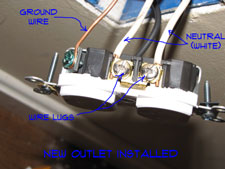
Installing electrical outlets, there could be several reasons why you would need to do that. Before you replace it though, make sure it is not something simpler. Is this something you can do? Is is something you want to do? In most cases yes, just be careful, electricity can be dangerous. A couple of simple tests will tell you where you are at with your outlets.
For the last few decades you will notice that the vertical slots are different sizes and all plugs that are made now have two sizes on the prongs. This is done to orient the polarity of the outlet. Devices with switches could be damaged by outlets that have the polarity reversed.
Not sure if this is your problem? See the articles, 'Troubleshooting Electrical Problems', 'Electrical Wiring Repairs' and 'Basic House Wiring' for more information and a listing of all the electrical subjects.
Before you begin an electric outlet installation, make sure the power is off. Turn off the breaker and put a piece of tape over it. Double check for power with a tester. Newer plugs all have three wires attached to them. A Hot (Black), Neutral (White) and a Ground (Bare or Green).
Removing an Old Outlet
Unhook the wires from the old receptacle, noting the orientation. Attach the ground wire to the green ground lug. Then attach the neutral to the silver side of the outlet. Lastly, attach the hot wire to the brass side of the outlet. This coding system is fairly universal. Depending on the light you have, you may have to look close to tell between the silver and brass lugs.
Using Push In Connections
 Some outlets may allow you to push the hot and neutral wires into the back of the outlet. There are round holes there. You strip the wire the proper distance, keeping it straight and simply push the wire in until the insulation touches the back of the receptacle.There should be a strip gauge on the side of the receptacle that tells you how far back to strip the insulation.
Some outlets may allow you to push the hot and neutral wires into the back of the outlet. There are round holes there. You strip the wire the proper distance, keeping it straight and simply push the wire in until the insulation touches the back of the receptacle.There should be a strip gauge on the side of the receptacle that tells you how far back to strip the insulation.
Even when you use the push in connection, you still want to tighten the lugs. These push connections are sometimes only good for one size wire, such as 14 gauge.
Using The Wire Lugs on an Outlet
Many homes use #12 wire for the outlets. This wire is rated tor up to 20 amps and can accommodate hight wattage items in kitchens and other locations.
The draw back to #12 wire is that unless you have an outlet rated for 20 amps, the push connectors will not work. They are made to work with #14 wire. This is assuming that you have purchased an inexpensive 15 amp receptacle.
You need to use a pair of wire strippers to bend the end of the wire to the correct shape to fit on the lugs. There is a hole above the handle that you can insert the wire into. Curl the strippers around 180 degrees to create a loop in the wire.
Loosen the lug as far as you can without removing it, before you try and put the loop in place. You may need to squeeze the loop a bit to get to fit onto the lug properly. Once you have the the wire curled around the lug, tighten the screw with a screwdriver.
Connecting Multiple Outlets
For outlets that had four wires attached you will need to reattach all of them. The extra two wires are to feed the next outlet in the circuit. This saves having to make additional connections inside of the box. It is a time saving feature that is very common.
Wrapping an Outlet.
As a safety precaution you want to wrap electrical tape around the lugs. This is especially needed if you have metal boxes. Use standard electrical tape and wrap it around the outlet two or three times. This helps protect the lugs from touching any other metal surface or wire inside of the box.
Finishing the Outlet Installation
The final step to install electrical outlets is to put it back together. Use the tester to make sure it is working. Attach the outlet back to the box and then install the cover plate. Got young children? Put the safety plugs back in. Congratulations! You can plug the lamp back in. It's time to move on to other electrical or home repairs.
This article covers a standard outlet that has the correct wiring inside of the box. For a GFCI outlet, see the article 'Installing GFCI Outlets'. If you are missing the ground wire, see the articles 'What Is a Grounded Outlet?' and 'How To Ground an Outlet' for more information and additional instructions.

